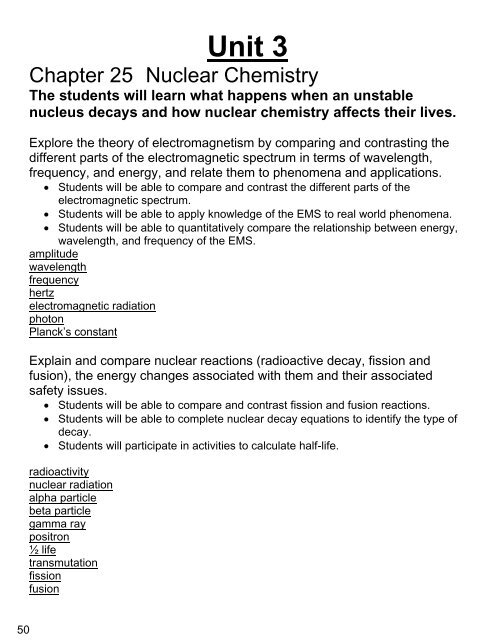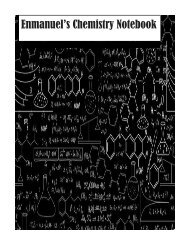You also want an ePaper? Increase the reach of your titles
YUMPU automatically turns print PDFs into web optimized ePapers that Google loves.
Unit 3<br />
Chapter 25 Nuclear <strong>Chem</strong>istry<br />
The students will learn what happens when an unstable<br />
nucleus decays and how nuclear chemistry affects their lives.<br />
Explore the theory of electromagnetism by comparing and contrasting the<br />
different parts of the electromagnetic spectrum in terms of wavelength,<br />
frequency, and energy, and relate them to phenomena and applications.<br />
Students will be able to compare and contrast the different parts of the<br />
electromagnetic spectrum.<br />
Students will be able to apply knowledge of the EMS to real world phenomena.<br />
Students will be able to quantitatively compare the relationship between energy,<br />
wavelength, and frequency of the EMS.<br />
amplitude<br />
wavelength<br />
frequency<br />
hertz<br />
electromagnetic radiation<br />
photon<br />
Planck’s constant<br />
Explain and compare nuclear reactions (radioactive decay, fission and<br />
fusion), the energy changes associated with them and their associated<br />
safety issues.<br />
Students will be able to compare and contrast fission and fusion reactions.<br />
Students will be able to complete nuclear decay equations to identify the type of<br />
decay.<br />
Students will participate in activities to calculate half-life.<br />
radioactivity<br />
nuclear radiation<br />
alpha particle<br />
beta particle<br />
gamma ray<br />
positron<br />
½ life<br />
transmutation<br />
fission<br />
fusion




